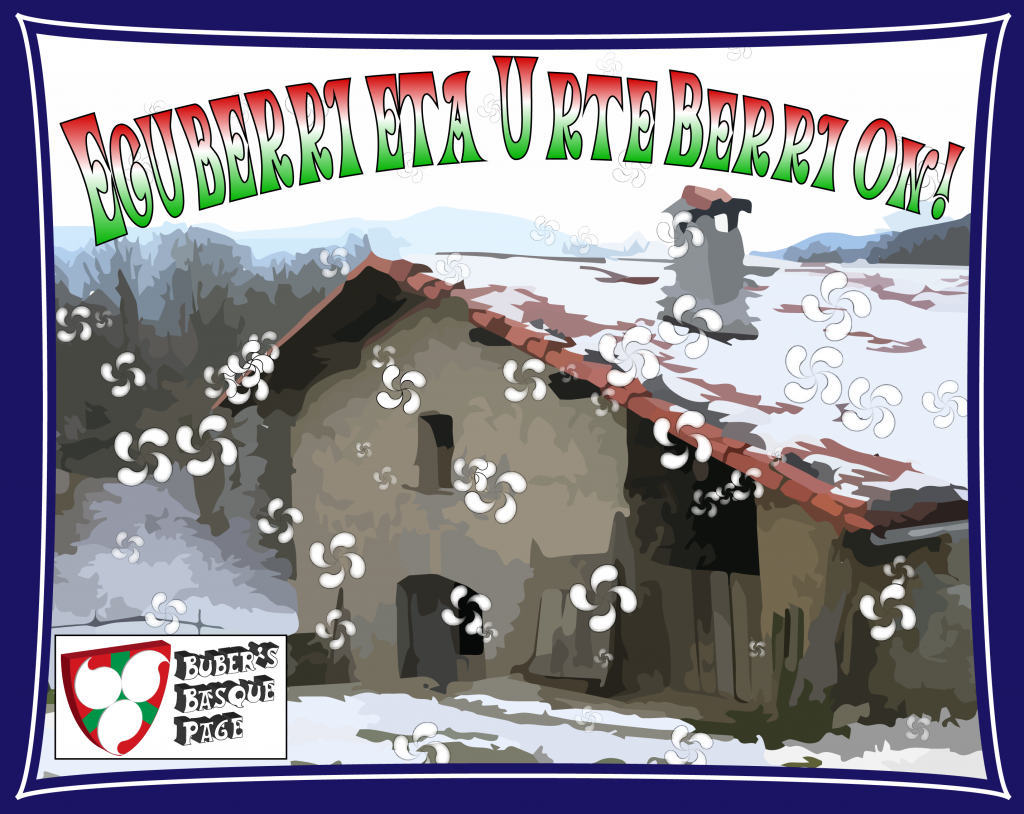
Eguberri on, or however you celebrate the holiday season, to all of the readers of Buber’s Basque Page!
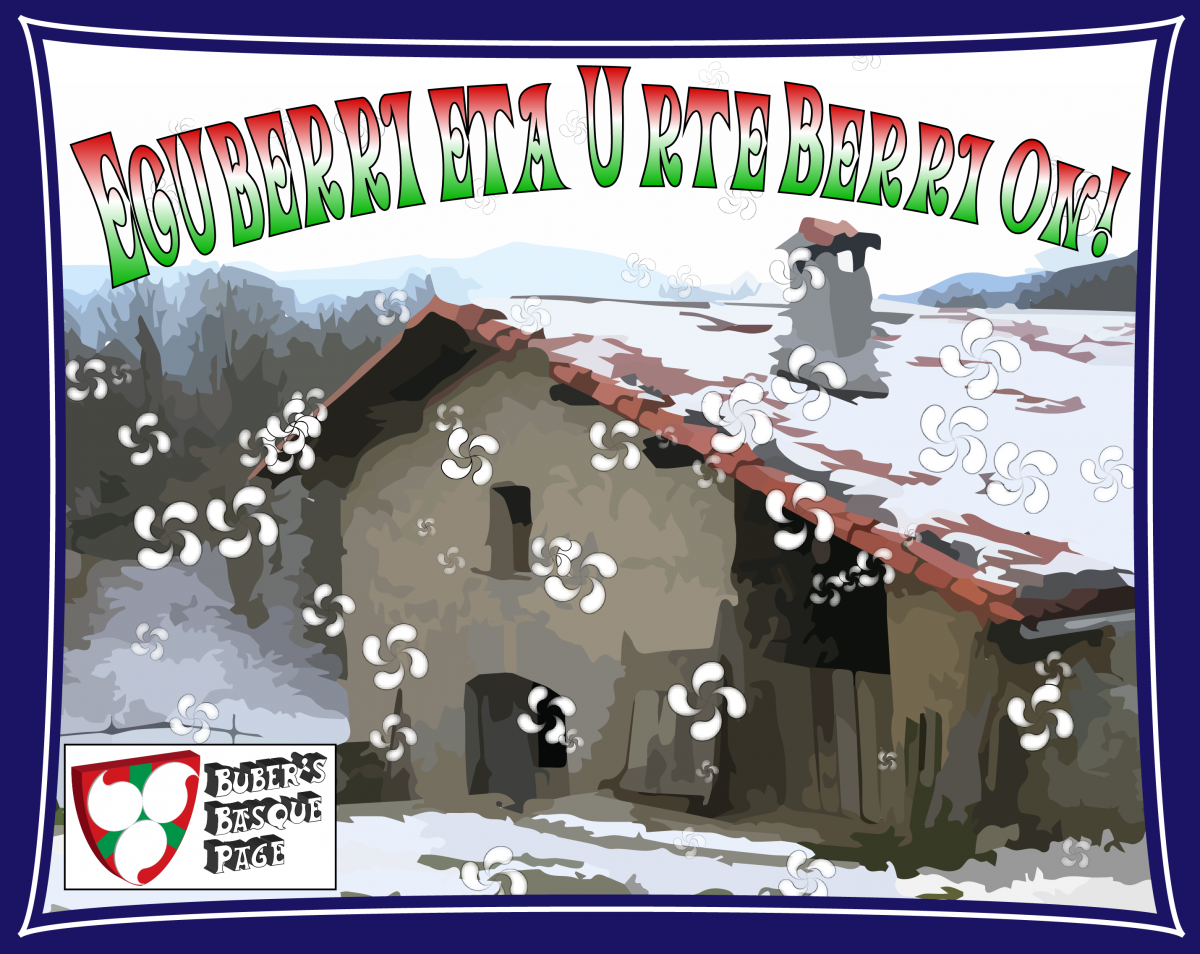
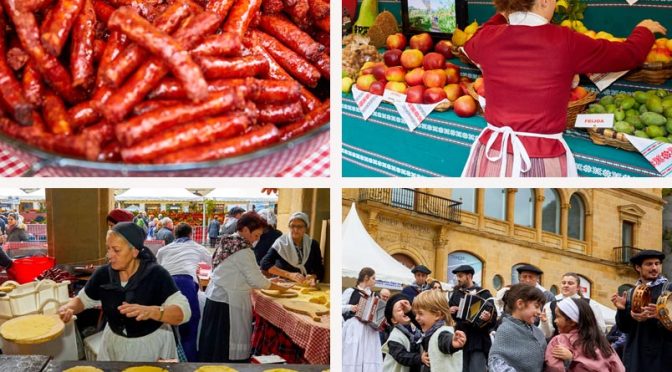
One of the biggest events to open the Christmas season in the Basque Country is the Feria of Santo Tómas, a rural market in the heart of the city. Originating in Gipuzkoa – more specifically Donostia – it has spread as a celebration throughout the Basque Country. Today, the Feria is a celebration of rural Basque traditions. People pull out their baserritarrak costumes – dressing as aitxitxa and amuma – and celebrate the baserri way of life. But the origins lie in the tradition of collecting rents on this day…
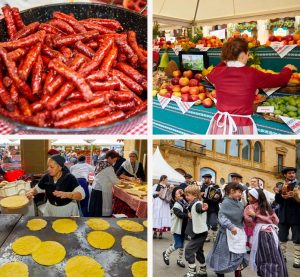
Primary sources: Sada Anguera, Javier María. Feria de Santo Tomás. Auñamendi Encyclopedia. Available at: https://aunamendi.eusko-ikaskuntza.eus/en/feria-de-santo-tomas/ar-154130/
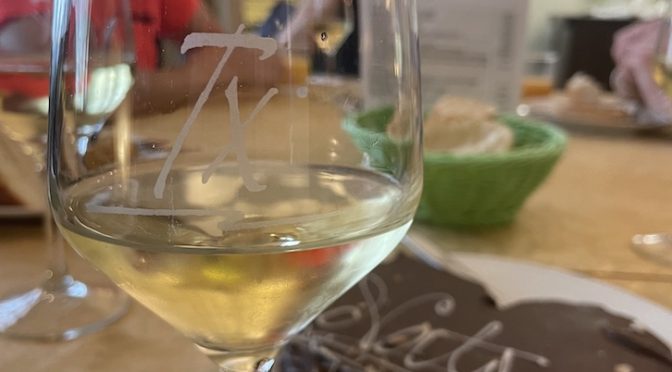
One of the unique pleasures of the Basque Country is all of the wonderful tastes it has to offer. I’ve written about some of the unique drinks you can find only in the Basque Country. Txakolin, or txakoli as it is more commonly known, is perhaps the most well known, having found its way across the globe. We were even able to find it in our local liquor store here in Santa Fe! Our last stop in our visit to the Basque Country before getting on the plane was El Txakoli, where we toasted to an amazing trip! Here’s to the next one!

Primary sources: Aguirre Sorondo, Antxon. Txakoli. Auñamendi Encyclopedia. Available at: https://aunamendi.eusko-ikaskuntza.eus/en/txakoli/ar-132636/; Txakoli, Wikipedia
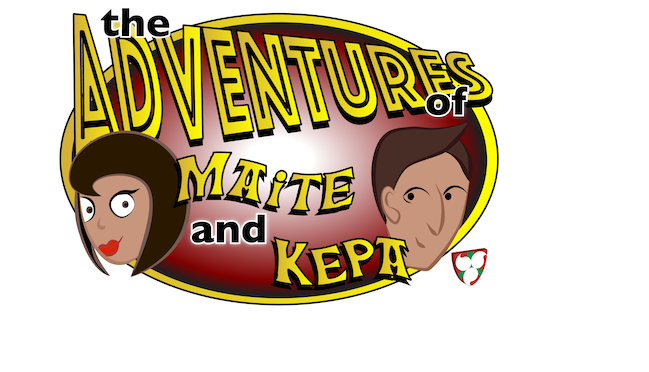
Maite panted as she reached the apartment door. She wasn’t sure why, but the steps up to the apartment were always the hardest. She was always tempted to take the elevator but had yet to succumb to that temptation, pushing herself to climb the four flights of stairs up to their floor.
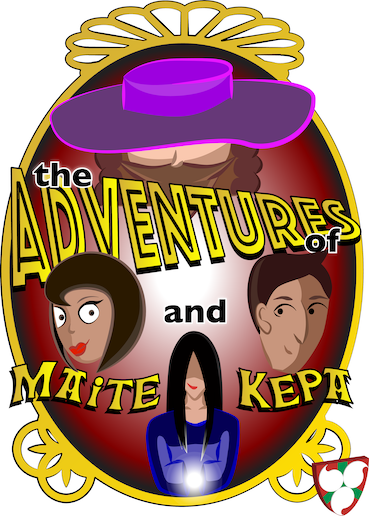
She pushed open the door. “I’m back!” she called as she threw her keys on the table and made her way to the bedroom. The shower at the end of the run was always the best part.
She stopped in her tracks as she passed through the bedroom doorway. Kepa was up on his knees in bed, naked, but that wasn’t the strangest part. The spectre of a woman floated in front of him, seemingly oblivious to his nakedness. Maite could see through her to the bathroom on the other side. The apparition was of a young woman with tanned skin and long blond hair that flowed behind her as if a gentle breeze lifted it up off of her shoulders. She was dressed in a loosely fitting golden, almost metallic gown that also flowed down and across her body, rippling as if some unseen force was pushing at her. As Maite stared in disbelief, the woman’s image shifted. The almost golden hair turned raven black and her skin, almost glowing, turned pale and white. Her gown also changed from bright gold to silver.
“Kepa…?” squeaked Maite as she just stood there, dumbfounded.
Both Kepa and the floating woman turned to look at her.
Maite pointed at Kepa’s waist. “You’re naked,” she stammered.
Kepa blushed as he pulled the sheets around him. He then turned back to Maite. “Maite, this is Amalur and her daughters Eguzki and Ilargi.”
The woman, who had looked quizically at Kepa as he covered himself, turned back to Maite. “Agur,” said the woman, greeting her formally in Euskara. Maite could understand the woman’s dialect, but it had a flavor of something ancient.
Maite wasn’t sure if she should bow or what, so she simply replied “Agur.” As she did so, the woman shifted again, this time to a somewhat older woman who wore earthy colors. Her hair was long and brown and full of curls which bounced in the unseen force that seemed to buffet her. She was as beautiful as her daughters, but had a sadness in her eyes that betrayed some suffering that her daughters had been spared.
“So,” began Kepa as he stood up off the bed, the sheets clutched in his hand as he tried to cover his nakedness. “I was goofing around, drawing symbols in the air with my magical finger, and she popped in.”
Maite’s brain still seemed to be short circuiting. “Magical finger?” was all she could muster.
Kepa held up his hand, his index finger extended. It began to glow. “The zatia…?” he ventured.
“Ah, bai,” Maite nodded. She shook her head to break the fog. “You drew the Amalur symbol with that finger,” she continued, putting the pieces together.
Kepa nodded. “And then she appeared.”
“I guess I’m glad you didn’t draw some symbol of an evil demon or something,” said Maite as she plopped down on the edge of the bed. She looked up at Amalur, who floated above them.
“Now what?” she asked.
If you get this post via email, the return-to address goes no where, so please write blas@buber.net if you want to get in touch with me.
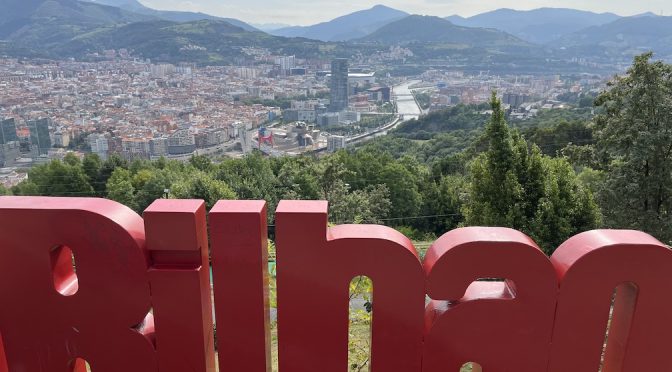
Sometimes, you just miss the most obvious things. I’ve been to Bilbo several times, but I never thought to take the funicular up to Artxanda. But, that’s the beauty of traveling with others, they make you think about things differently, explore new avenues, push you beyond the familiar. The funicular itself is iconic, though in the height of summer it was crammed full of sweaty people. Still, we took it up and took in the sites that Artxanda, a beautiful green space overlooking downtown Bilbo, offers. Well worth the cramped quarters!
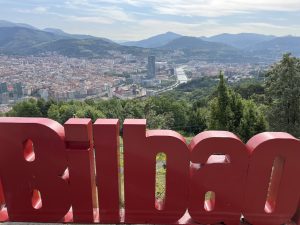
Primary sources: Artxandako Funikularra; Artxanda: el histórico vigía de Bilbo, Naiz; Auñamendi Entziklopedia. ARTXANDA. Auñamendi Encyclopedia. Available at: https://aunamendi.eusko-ikaskuntza.eus/en/artxanda/ar-22626/

Kepa lay in bed, staring at the ceiling. Maite had gotten up early to go for a jog along La Concha. She had invited Kepa to join her, but he wasn’t really a jogger. He needed a competitive element to get him motivated to exert himself. A game of basketball with friends, that was great. A partido of mano in the fronton, that was the kind of thing that got him going. Running for the sake of running? He never quite understood that.

He let his eyes sort of defocus as he stared at the ceiling, little floaters flittering across his vision. Sometimes he saw shapes in the fuzzy black blobs and lines that danced across his vision, but most of the time he simply tried to track them. When he shifted his eyes to look more directly at one, it always seemed to shift away, to the side of his vision, always fuzzy and grey.
“Just like these symbols,” he said to himself. “Always just a little out of focus, always just beyond my grasp.”
He flicked his eyes back and forth, driving the floaters across his field of vision, not ready to get out of bed and start his day.
After a while, he got bored of chasing floaters. He held his hand in front of his face and forced his finger tip to glow. Staring at the bright light, he moved his finger, drawing in the air. When he closed his eyes, the after image remained, his drawing almost brought to life on the back of his eyelids. He wrote out Maite’s name and there it was, almost burned into his vision. He tried to draw a virtual picture of her face, but it turned out to be a distorted caricature. He blinked furious to try to erase the hideous image from his eyes.
He absent mindedly continued drawing random shapes in the air, burning them into his retina and watching them fade against the blackness of his closed eyelids. At some point, without really thinking about it, he drew a circle. Within the circle he drew a triangle. Next to one point of the triangle he drew another circle and, next to the other, he drew a crescent.
“Amalur,” he mumbled to himself as he closed his eyes, focusing on the after image of the symbol that Ainhoa had tattooed on her shoulder, that filled Marina’s journal. “What does it mean?”
Instead of fading, the symbol grew brighter and brighter against the back of his eyelids, to the point that it was almost painful. He shoved his hands against his eyes trying to block the light, but it was coming from inside his eyes. He was about to scream when the light suddenly vanished. Rubbing his eyes, he opened them. Blinking, it took a moment for his eyes to adjust back to the ambient light. As they did, he found himself staring at the apparition of a woman.
If you get this post via email, the return-to address goes no where, so please write blas@buber.net if you want to get in touch with me.
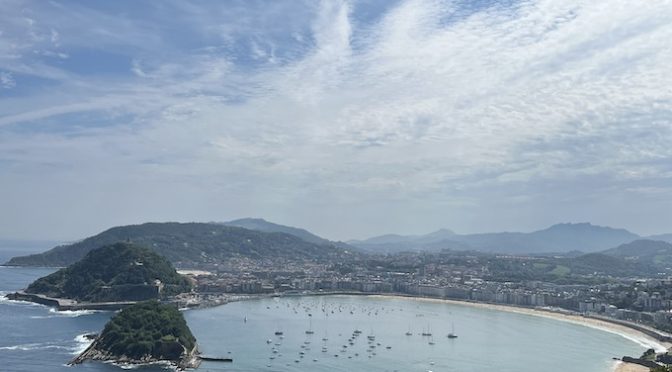
Perhaps the most iconic vista of La Concha and Donostia is from Mount Igeldo, the peak that rises to the west of the city. A small winding road leads from the city up the slope to an amusement park that hosts this most amazing view. You can also grab a funicular that will take you from the city to the top, something I still need to do.
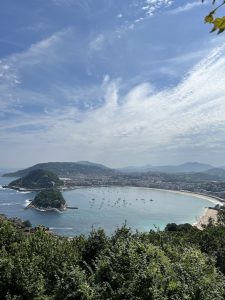
Primary sources: Arozamena Ayala, Ainhoa; Cendoya Echániz, Ignacio. IGELDO. Auñamendi Encyclopedia. Available at: https://aunamendi.eusko-ikaskuntza.eus/en/igeldo/ar-73055/; Igueldo, Wikipedia; Mount Igeldo, Donostia/San Sebastian Tourismoa; Parque de Atracciones Monte Igueldo, Wikipedia; La Otra Cara de Igueldo, Diario Vasco

Sorry for the silence. I was on work travel and then I caught COVID just in time for the holiday. Feeling much better now and finally testing negative. Stay safe and healthy, everyone.
“Well,” said Maite as she climbed back into the car, “that was a bust.”

“What do you mean?” replied Kepa as he pulled the car out onto the road. “We learned that these symbols are related to ancient Basque beliefs.”
“So?” asked Maite exasperated. “How does that help us?”
Kepa shrugged sheepishly, feeling slightly reprimanded. “I’m not sure, not yet. But it’s more than we knew before.”
Maite nodded. “That’s true.” After a moment’s silence, she added “Sorry for snapping at you.”
Kepa let out a sigh of relief. “No worries. This is frustrating for both of us.”
“If the zatiak – the magic of these witches – is related to Basque mythology, what does that mean?” asked Maite rhetorically.
“That the Basque gods were real?” ventured Kepa.
Maite shook her head. “Not necessarily. I do admit that there are things beyond our understanding here, but I’m not ready to recognize the existence of prehistoric gods.”
“Does Garuna have any theories?”
“I haven’t bothered to ask it, to be honest,” replied Maite. “But, it can’t hurt.”
Kepa watched as Maite laid her head back, having what he must imagine was one of the strangest internal dialogues any person has ever had. He just wished he was privy to it.
“So,” asked Maite in her thoughts. “What does this mean? This symbol of Amalur and her daughters?”
Garuna rumbled from the depths of her mind. “I find it somewhat insulting that you only want to talk when you need something.”
“Why else would I talk to you?”
“So I can learn more about your time and the world around us.”
“So you can take it over?”
There was a silence before Garuna finally responded. “I don’t know what the symbols mean. The ancient Basque gods are nothing more than myth. I have never seen any evidence that they are more than that.”
“What about the zatiak? Might they not be evidence?”
“They are evidence of something. But what, I cannot say. They are beyond my experience.”
“They were. But now they are an intimate part of your experience. They are why you are here.”
“That is true. But I have not had the ability to really analyze them. One sample does not make for a representative set.”
“I guess we’ll have to find more for you to analyze then.”
“That would be… desirable.”
Maite sighed. She feared what Garuna would do with the power of the zatiak or, worse, with her body holding that power.
She shook her head, as if waking from a deep sleep.
“He’s got nothing,” she said aloud as she turned to Kepa.
“Well,” he replied. “I guess we file this one away until we can learn more.”
If you get this post via email, the return-to address goes no where, so please write blas@buber.net if you want to get in touch with me.
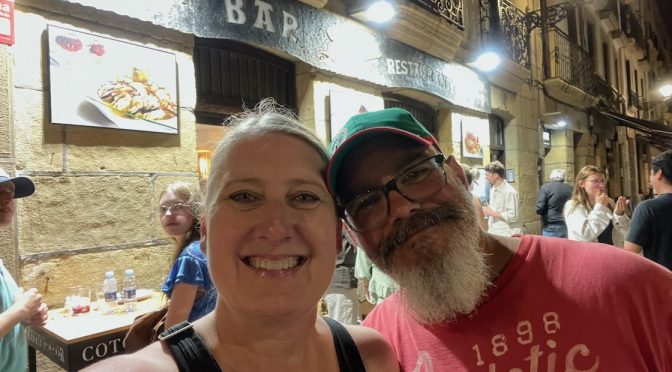
Our night in the Parte Vieja started off at a cocktail bar, Arraun, where everyone else (I’m a beer and kalimotxo drinker) had some of the fanciest drinks I’ve seen in quite a while. It was cool to find such a non-traditional spot in the heart of all of these pintxo bars. But, really, those pintxo bars were the main attraction and we hit several of them, with one highlight being La Viña where the now famous burnt Basque cheesecake was created. It is amazing that what is now a global phenomenon started off at this little spot in the Parte Vieja!
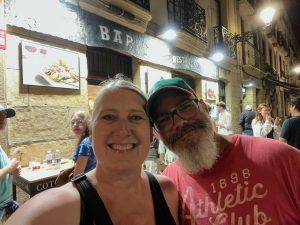
Primary sources: La Vina’s webpage; The story behind Basque burnt cheesecake, National Geographic; The True Story Behind Burnt Basque Cheesecake—and the Pintxo Bar That Created It, Condé Nast Traveler
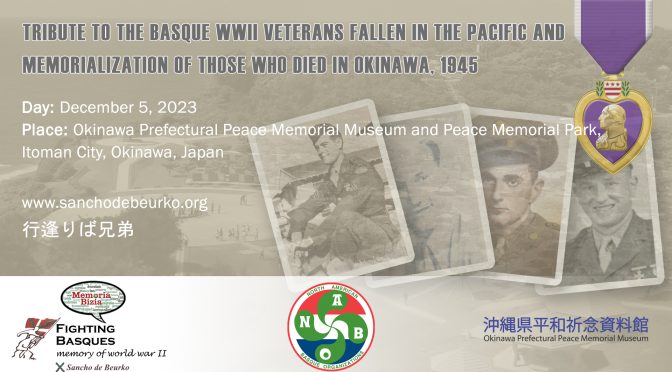

On the 5th of December, a small ceremony will take place on the Japanese island of Okinawa in which tribute will be paid to all American veterans of Basque origin who died during World War II (WWII) in the Pacific, with special recognition for those who perished on the island. They were over twenty young Basque-Americans, six of them killed in Okinawa. Their identification and now visibility and public recognition are the result of the research project Fighting Basques: Memory of WWII, led by the homeland history association Sancho de Beurko since 2015. To date, more than 1,600 combatants of Basque origin have been identified in the United States Armed Forces, of which 1,100 biographies of both the veterans and their emigrant families have been completed.
This event is the result of a collaboration between the Okinawa Prefectural Peace Memorial Museum and the Sancho de Beurko Association, under the auspices of the North American Basque Organizations (NABO).
The Battle of Okinawa (March 26-June 22, 1945) was the last major battle of the last world conflict, in which more than 12,500 American soldiers fell, including five Basques, and more than 36,000 were wounded, many of whom died after the battle. On the Japanese side, more than 77,000 soldiers and more than 100,000 Okinawan civilians died. A sixth Basque died on the island as a result of a tragic accident at the end of the war. This will be the first tribute on Japanese soil to our Basque WWII veterans.
Among them is Sergeant Joseph Uriola Alcorta, born in Boise, Idaho, on May 22, 1919, to immigrant parents from Bizkaia, Juan Urriolabeitia, a native of Markina, and María Dolores Alcorta, born in Ondarroa. Joseph enlisted in the US Army a few months before the United States entered the war. As a member of the 184th Regiment of the 7th Infantry Division he participated in the Aleutian Islands Campaign and in the battles of Kwajalein and Leyte. Joseph was killed in combat on April 7, 1945, in Okinawa, at the age of 25. He received the Purple Heart and a Bronze Star, posthumously, for saving the life of a wounded comrade in the Philippines.
Dr. Pedro. J. Oiarzabal, co-principal investigator of “Figthing Basques,” will travel to Okinawa to participate in the event. He will also take the opportunity to see WWII memorials first-hand, as NABO will soon launch a fundraising campaign with the goal of establishing the first national WWII memorial to publicly recognize the selfless service of Basque and Basque-American veterans.